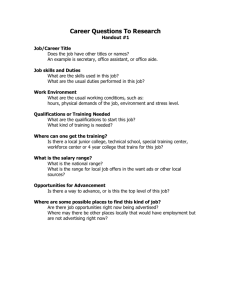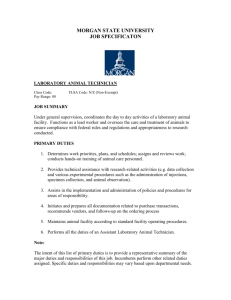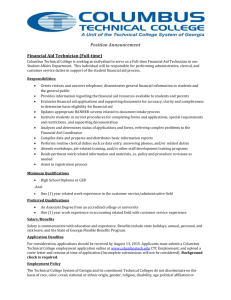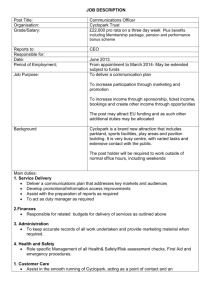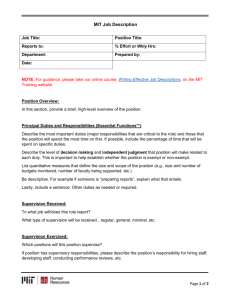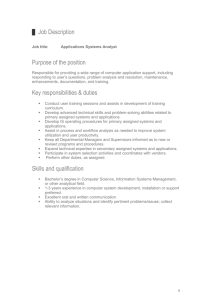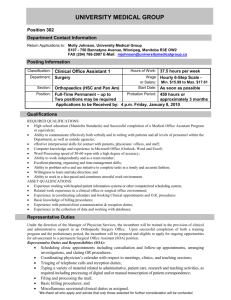Job Description Package
advertisement
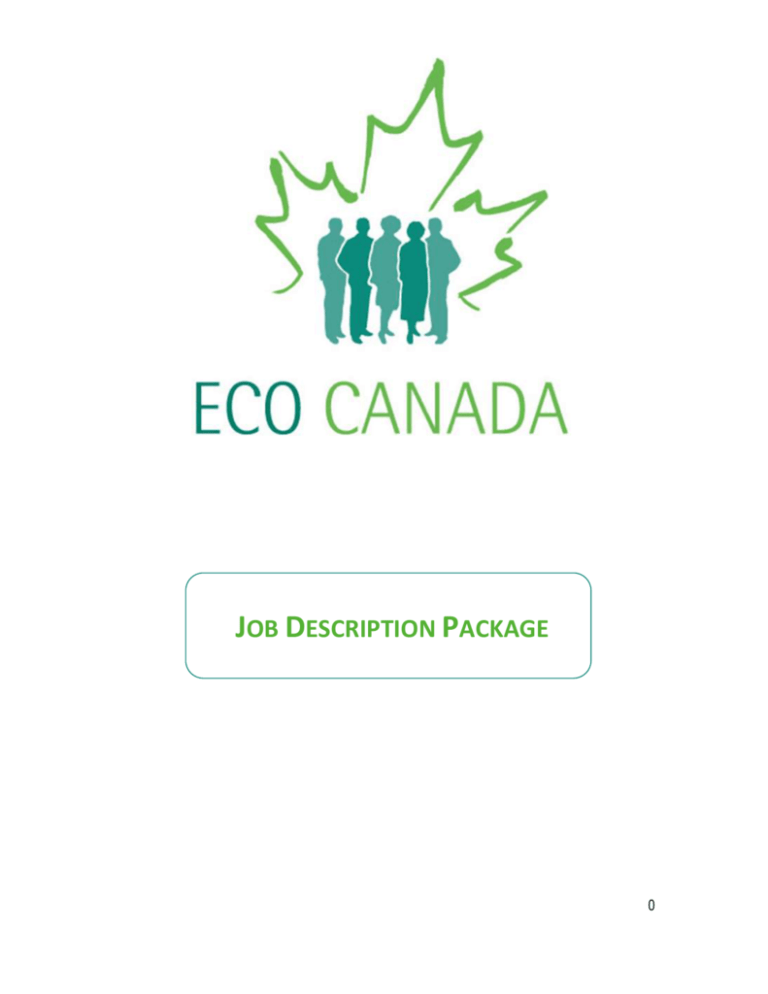
JOB DESCRIPTION PACKAGE 0 HOW TO WRITE A GREAT JOB DESCRIPTION TABLE OF CONTENTS Introduction to Writing Job Descriptions 2 Job Description Guide (General Template) 3 General Tips & Common Errors 4 Example Template: Environmental Engineer 5 Example Template: Geologist 7 Example Template: Environmental Project Manager 9 Example Template : Reclamation Specialist 10 Example Template: Environmental Scientist 11 Example Template: Environmental Health & Safety Technician 13 Example Template: Soil Scientist 15 Example Template: Environmental Technician 17 Example Template: Biologist 19 Example Template: Environmental Land Planner 21 Appendix A: Employment Law by Province 22 Appendix B: How to Write a Duties & Responsibility Statement 23 Appendix C: Glossary of Action Verbs 24 1 HOW TO WRITE A GREAT JOB DESCRIPTION INTRODUCTION TO WRITING JOB DESCRIPTIONS A well-crafted job description can be an important tool in attracting the right candidates. In order to write an effective job description, it is imperative to concisely communicate the key responsibilities of the position, and qualifications or skills required for the job. Doing so will increase the odds of attracting candidates with the right training, experience and skills to fit the position. In addition to attracting the right candidates, a well-written job description can be used to: Communicate clear employee expectations Determine compensation Identify training and development areas Serve as a tool for employee performance evaluation and management The following series of templates and tools will help you create job descriptions for some of the most popular environmental positions. To easily create a job description for your unique position, go to ECO Canada’s collection of environmental occupational profiles - where you can find general job duties and requirements, salary information, educational requirements and more. You can search for your desired occupation alphabetically and follow the formatting of the ECO job description template, copy and paste key job duties and qualifications related to your position. You can then add your own attributes specific to the needs of your position / organization. TIPS Adapt the information using your own words to describe the work performed by employees Combine information from different occupational profiles to better identify the job performed by your employees, especially if positions in your organization have tasks that span more than one position 2 HOW TO WRITE A GREAT JOB DESCRIPTION JOB DESCRIPTION GUIDE The following guide specifies what type of information should be included in each section of a job description, along with helpful tips and resources to assist you as you write your own job description. Please note: all fields highlighted in blue should be included in all job descriptions regardless of the use. All fields highlighted in purple only need to be added when the job description is being used for a job posting. JOB TITLE: State the formal title of the position Employment Type: Full-time, Part-time, Contract, Casual, Internship, etc. Job Location: City and Province Reports to: Line Manager, CEO, etc. (List all) Date Posted: First day accepting resume Closing Date: Last day accepting resumes Apply by: Preferred method of receiving resumes: E-mail, fax, mail or in person Company Information Provide a brief description regarding your organization. This can include your company’s mission, values or what your company does. Job Purpose Provide a brief description to summarize the purpose of the position. This may be expressed in terms of duties to be performed, results to be achieved or key contributions to be made. The job purpose should be no more than a couple sentences long. Qualifications Describe the minimum qualifications necessary to successfully perform the job. These are the mandatory qualifications required to be considered for the position. Qualifications include: Education Experience Specialized knowledge Skills Other training or seminars Other characteristics such as personal characteristics Professional certification such as EP certification * Please note: all qualifications must comply with provincial human rights legislation. (Appendix A) 3 HOW TO WRITE A GREAT JOB DESCRIPTION Duties and responsibilities Identify between 6 to 11 primary duties and responsibilities for the position List the duties and responsibilities in order of importance Begin each statement with an action verb and use the present tense. See Glossary of Job Description Verbs for assistance (Appendix C) Use gender and culturally neutral language to describe the work Use universal language such a photocopy instead of Xerox State working conditions (whether it will require working at odd hours, etc.) Describe only the duties, skills and knowledge required of the position, and avoid describing personal traits Where appropriate use qualifiers to clarify the task – where, when, why or how often. Avoid words that are open to interpretation or ambiguous statements – for example instead of “handle incoming mail” specify “sort and distribute incoming mail” State any targets that are expected to be met by the employee *For more assistance writing job duties and responsibilities, please refer to the “How to Write a Duties & Responsibilities Statement (Appendix B) Physical requirements List any physical requirements of the job. For example, if the employee will be required to stand for extended periods of time, lift heavy objects, sit at a computer all day, perform repetitive tasks, etc. OTHER GENERAL TIPS Describe the position as it is now, not how it may be in the future Do not understate or overstate work requirements Focus on job requirements, not the person performing the job Describe only the ongoing and/or continuing responsibilities of the job Try to describe the work of the job for someone not familiar with the work Consider adding a generic statement - "Performs other related duties and responsibilities consistent with the position as required" as an additional responsibility statement - this encourages employees to ‘work outside the box’ and helps discourages the “that’s not my job” excuse Avoid using technical terms, acronyms or abbreviations COMMON ERRORS A description that is too long, with too many details, many of which are irrelevant A description is too short and superficial and, as a result, fails to capture the elements of the job An emphasis on minor aspects of the job. For example, “the position is primarily financial, but human resource responsibilities have been placed first” There are incomplete or missing facts such as information on the number of subordinates, key responsibilities, travel requirements etc. 4 HOW TO WRITE A GREAT JOB DESCRIPTION EXAMPLE JOB DESCRIPTION #1: ENVIRONMENTAL ENGINEER Environmental Engineer Employment Type: Full-time Job Location: Calgary, Alberta Reports to: Manager of Engineering Date Posted: Wednesday Sept 28, 2011 Closing Date: Monday, Oct 17, 2011 Apply by E-mail at jobs@ecojobs.ca Company Information Provide a brief description regarding your organization. This can include your company’s mission, values or what your company does. Job Purpose The Environmental Engineer works closely with the Environmental, Permitting, and Engineering teams to develop, review, and oversee water, wastewater, solid waste, and air quality management programs to support permitting, construction, operations, and closure of the ECO creek mine. Qualifications Bachelor Degree in environmental engineering, engineering, air sciences, or related field. 2-5 years experience in environmental engineering, environmental science, or compliance, preferably in the mining industry Experience in PSD permitting, permit compliance and compliance testing for criteria and hazardous air pollutants is preferred Ability to understand and communicate technical aspects of water quality, waste management, and reclamation requirements Knowledge of Autocad Professional designation Professional Engineer (PE) or Environmental Professional (EP) is preferred Duties and Responsibilities Support environmental management initiatives including policy planning, corporate reporting and due diligence Develop and implement procedures ensuring the operation maintains compliance with all corporate and regulatory approvals, practices and standards Develop and implementation of regulatory compliance programs involving: Compliance with Federal regulations Training for compliance Support and development of an Environmental Management System (EMS) and related activities 5 HOW TO WRITE A GREAT JOB DESCRIPTION Work with environmental field staff to develop and implement environmental operational controls and programs Coordinate environmental assessments, monitor and report programs with consultants and field staff Develop corporate environmental communications and disclosure materials for external and internal audiences Actively participate in industry and regional environmental management forums and multistakeholder groups as required Develop and support emissions measurement and reporting systems, including Greenhouse Gas (GHG) measurement and reporting Performs other related duties and responsibilities consistent with the classification of the position Working Conditions The Environmental Engineer will be required sit and perform computer work for extended periods of time. 6 HOW TO WRITE A GREAT JOB DESCRIPTION EXAMPLE JOB DESCRIPTION #2: GEOLOGIST Geologist Employment Type: Full-time Job Location: Calgary, Alberta Reports to: Senior Hydrogeologist Date Posted: Wednesday Sept 28, 2011 Closing Date: Monday, Oct 17, 2011 Apply by E-mail at jobs@ecojobs.ca Company Information Provide a brief description regarding your organization. This can include your company’s mission, values or what your company does. Job Purpose The Geologist works closely with the Senior Hydro geologist to develop, review, and oversee water, wastewater, solid waste, and air quality management programs to support drilling and field operations on several major field projects in Southern Alberta Qualifications Bachelor degree from recognized University in geology, hydrogeology or engineering discipline Excellent written and oral communication Proven ability to work independently and in a team environment Familiarity with drilling techniques, installation of monitoring and production wells and soil and groundwater sampling procedures Experience in using water level meters, data loggers, EC meters, electronic submersible pumps, etc...for gathering hydrogeology and environmental related data Proficiency with MS Software WORD, EXCEL, is required Duties and Responsibilities Plan, direct and participate in the logging of soil cuttings and assist in the design and construction of small-diameter groundwater monitoring wells and larger-diameter water supply wells Compile field notes and prepare report-ready graphs, figures, tables, and reporting Collect and analyze samples, for example rock, soil, and core samples Process and interpret geophysical data acquired using gravitational, magnetic, electromagnetic, seismic, and other remote sensing methods Set up and conduct/monitor short and long-term well and aquifer tests Operate and maintain geophysical survey and well-logging instruments and equipment 7 HOW TO WRITE A GREAT JOB DESCRIPTION Conduct geophysical surveys for locating environmental problems, for example contaminant plumes and buried hazardous waste mapping Maintain geological and geophysical databases Analyze core samples from drilling sites Interpret hydrogeological maps, reports, and studies Extract and interpret geological information from aerial photographs, satellite images, contour maps, and cross sections Working Conditions Candidate must be comfortable working in remote field settings in winter weather. 8 HOW TO WRITE A GREAT JOB DESCRIPTION EXAMPLE JOB DESCRIPTION #3: ENVIRONMENTAL PROJECT MANAGER Environmental Project Manager Employment Type: Full-time Job Location: Vancouver, BC Reports to: Senior Project Manager Date Posted: Wednesday Sept 28, 2011 Closing Date: Monday, Oct 17, 2011 Apply by E-mail at jobs@ecojobs.ca Company Information Provide a brief description regarding your organization. This can include your company’s mission, values or what your company does. Job Purpose The Intermediate Project Manager works closely with the Senior Project Manager and Project Coordinators to plan, develop, review, and oversee water, wastewater, solid waste, and air quality management programs to support drilling and field operations on several major field projects in Southern Alberta. Qualifications Bachelor degree in Civil Environmental Engineering and or Hydrogeology Currently registered or eligible for registration with PEO or APGO Master degree in Environmental Engineering or Geoscientist Studies would be an asset Minimum 5 to 8 years of experience in Environmental or Geoscientist activities Valid G Driver’s License and must be willing to provide a driver’s abstract for review Demonstrated experience specifically with contaminated site assessment, hydrogeology, and a fieldwork background is required Duties and Responsibilities Work directly with clients to provide strategic advice and project management throughout stages. Contribute to and lead business development activities, including proposals, relationship building with clients and potential clients Manage tasks and projects according to approved scopes of work, and deliver quality reports on schedule and within budget Travel to remote sites and extended out of town work and field work will be required Review and complete environmental audits and identify areas for improvement Assign, co-ordinate and review the technical work of the department or project team Working Conditions Candidate must be comfortable working out of town, in remote settings, in all types of weather. 9 HOW TO WRITE A GREAT JOB DESCRIPTION EXAMPLE JOB DESCRIPTION #4: RECLAMATION SPECIALIST Reclamation Specialist Employment Type: Full-time Job Location: Ottawa, ON Reports to: Senior Project Manager Date Posted: Wednesday Sept 28, 2011 Closing Date: Monday, Oct 17, 2011 Apply by E-mail at jobs@ecojobs.ca Company Information Provide a brief description regarding your organization. This can include your company’s mission, values or what your company does. Job Purpose The Reclamation Specialist will be accountable for successfully consulting on site investigation, conducting on-site evaluations and analysis of environmental conditions, and remediation related projects to build a sustainable business locally, while networking with the global Contaminated Site Management practice team to share best practices across the industry. Qualifications Bachelor degree in Environmental Science, Environmental Engineering or Environmental Earth Sciences Minimum 2 to 4 years of experience in Reclamation Valid Driver’s License (must be willing to provide a driver’s abstract for review) Demonstrated experience specifically with contaminated site assessment, hydrogeology, and a fieldwork background is required Duties and Responsibilities Administer and conduct activities for reclamation projects Conduct on-site evaluations and analysis of environmental conditions, including soil, groundwater, surface water, and air quality characteristics Identify contaminants and map pollution pathways and their environmental impacts Research techniques for reclamation of disturbed land and water bodies Secure applicable federal and provincial environmental approvals and certificates Liaise with clients and regulatory bodies Generate and administer contracts Evaluate and monitor reclamation projects, including site preparation, remediation, sampling protocols, and results Working Conditions Candidate must be comfortable working out of town, in remote settings, in all types of weather. 10 HOW TO WRITE A GREAT JOB DESCRIPTION EXAMPLE JOB DESCRIPTION #5: ENVIRONMENTAL SCIENTIST Environmental Scientist Employment Type: Full-time Job Location: Edmonton, AB Reports to: Senior Environmental Scientist Date Posted: Wednesday Sept 28, 2011 Closing Date: Monday, Oct 17, 2011 Apply by E-mail at jobs@ecojobs.ca Company Information Provide a brief description regarding your organization. This can include your company’s mission, values or what your company does. Job Purpose The Environmental Scientist works closely with the Senior Environmental Scientist to collect, synthesize, analyze, and report environmental data, such as pollution emission measurements, atmospheric monitoring measurements, meteorological and mineralogical information, and soil or water samples on several major field projects in Northern Alberta. Qualifications Bachelor's degree and/or advanced degree in Environmental Science or a related field Possess or be eligible for professional accreditation – biology, engineering, or agrology A minimum of 5+ years progressive experience providing environmental services particularly in the oil and gas and mining industry Demonstrated knowledge and experience in federal and provincial environmental legislation, regulations and processes Excellent organizational and project management skills with the ability to manage and prioritize several assignments at one time, while ensuring delivery within tight deadlines and budgets Strong written and oral communication skills Valid Driver’s License Duties and Responsibilities Collect, synthesize, analyze, and report environmental data, such as pollution emission measurements, atmospheric monitoring measurements, meteorological and mineralogical information, and soil or water samples. Analyze data to determine validity, quality, and scientific significance, and interpret correlations between human activities and environmental effects. Provide scientific and technical guidance, support, coordination, and oversight to governmental agencies, environmental programs, industry or the public. Communicate scientific and technical information to the public, organizations or internal audiences through oral briefings, written documents, workshops, conferences, training sessions or public hearings. 11 HOW TO WRITE A GREAT JOB DESCRIPTION Process and review environmental permits, licenses and related materials. Review and implement environmental technical standards, guidelines, policies and formal regulations that meet all appropriate requirements Working Conditions Candidate must be comfortable working out of town, in remote settings, in all types of weather. 12 HOW TO WRITE A GREAT JOB DESCRIPTION EXAMPLE JOB DESCRIPTION #6: ENVIRONMENTAL HEALTH & SAFETY TECHNICIAN Environmental Health & Safety Technician Employment Type: Full-time Job Location: Edmonton, AB Reports to: General Manager Date Posted: Wednesday Sept 28, 2011 Closing Date: Monday, Oct 17, 2011 Apply by E-mail at jobs@ecojobs.ca Company Information Provide a brief description regarding your organization. This can include your company’s mission, values or what your company does. Job Purpose The Environmental Health & Safety Technician is responsible for ensuring facility operations comply with federal, provincial and local regulations. This includes environmental, industrial hygiene, occupational health & safety regulations, and Transportation of Dangerous Goods. Qualifications Bachelor degree in Environmental or Safety (or a related field) Ability to interpret and communicate regulations Proven interpersonal skills Intermediate competency with Computers (Microsoft Word, Excel, Powerpoint) Auditing experience CRSP (Canadian Registered Safety Professional) Designation or in process Valid driver’s license and must own or have access to a personal vehicle Duties and Responsibilities Identify health hazards and implement control measures Monitor and control water, air, and noise pollution and collect samples for chemical and microbiological analysis to make certain they are within existing limits Prepare policy documents, guidelines, pamphlets, and brochures relating to environmental health matters Undertake risk assessments for activities that could affect community health. Ensure compliance with federal and provincial health regulations and municipal bylaws and enforce laws where necessary Create and deliver programs in areas of infectious disease control, food safety, health hazard investigation, injury prevention, and water quality 13 HOW TO WRITE A GREAT JOB DESCRIPTION Assist in the development of new health and safety laws and policies Participate on boards, committees, and working groups Working Conditions Work is normally performed in a typical office work environment but also requires extended periods on production floor and on site visits. 14 HOW TO WRITE A GREAT JOB DESCRIPTION EXAMPLE JOB DESCRIPTION #7: SOIL SCIENTIST Soil Scientist Employment Type: Full-time Job Location: Saskatoon, SK Reports to: Contaminated Sites Team Lead Date Posted: Wednesday Sept 28, 2011 Closing Date: Monday, Oct 17, 2011 Apply by E-mail at jobs@ecojobs.ca Company Information Provide a brief description regarding your organization. This can include your company’s mission, values or what your company does. Job Purpose The Soil Scientist is responsible for a wide variety of environmental projects involving soil classification and sampling, irrigation suitability studies, conservation and reclamation plans, contaminated site assessments, remediation monitoring and report writing. Qualifications M.Sc. in Soil Science or related field Understanding of environmental issues affecting soils Experience conducting and coordinating field work Strong data analysis and technical reporting skills Understanding of the regulatory environment in Manitoba Duties and Responsibilities Study soil origins and composition, as well as nutrient movements from soil to the atmosphere and into water systems Study organisms in the soil and how they contribute to ecosystem function and stability. Manipulate soil organisms to improve productivity, reclamation success, or to achieve other goals Study plant and crop responses to added nutrients and soil amendments Collect and analyze soil samples and data from a range of environments Collect data and build computer simulation models for estimating water budgets and contaminant transport in soils Prepare reports describing land and soil characteristics Investigate issues of soil quality and monitor activities to assure compliance with applicable regulations Investigate and remediate soil that has been negatively impacted by human activities, for example oil and gas, manufacturing plants, and landfills 15 HOW TO WRITE A GREAT JOB DESCRIPTION Manage soil for land enhancement, for example landscape design, mine reclamation, and site restoration Evaluate soils as they relate to natural resource management, for example forest soil properties, ecological evaluations, and endangerment assessments Provide advice on soil usage to practitioners in other industries, including agriculture and forestry Working Conditions Extended hours, outdoor conditions and out of town work will be required. 16 HOW TO WRITE A GREAT JOB DESCRIPTION EXAMPLE JOB DESCRIPTION #8: ENVIRONMENTAL TECHNICIAN Environmental Technician Employment Type: Full-time Job Location: Calgary, Alberta Reports to: Senior Environmental Technician Date Posted: Wednesday Sept 28, 2011 Closing Date: Monday, Oct 17, 2011 Apply by E-mail at jobs@ecojobs.ca Company Information Provide a brief description regarding your organization. This can include your company’s mission, values or what your company does. Job Purpose The Environmental Technician will be responsible for providing support to existing and future projects in mine dewatering, potable water supply, environmental assessment, site remediation and geotechnical engineering projects. Qualifications Degree or Diploma in Engineering Technology, Environmental Science or Related Minimum 2+ years biological and/or contaminated site experience as Environmental Field Technician/EIT Familiarity with MS Office applications ECO Canada Environmental Professional considered an asset Duties and Responsibilities Gather air, water, and soil samples to determine contamination level and assess environmental conditions Perform chemical, physical, and biological tests on air, water, and soil samples and document results Participate in and lead field investigations and inspections Trace chemical, physical, and biological pathways of environmental pollutants Review and process applications for environmental permits or certification, for example waste disposal sites or water and wastewater treatment plants Issue instructions for corrections necessary to comply with federal and provincial regulations Explain and interpret regulations and procedures for environmental licensing applicants Relate economic, health, political, and social issues to the management of environmental systems in both industrial and municipal applications Design methodologies for environmental sampling and analysis 17 HOW TO WRITE A GREAT JOB DESCRIPTION Measure field characteristics, properties, and composition of soils, river channels, and biological systems Prepare reports of findings for clients and supervisors Physical Requirements The Environmental Technician will be required to work in remote field settings in winter weather and be required to lift and carry materials. He/she will also be required to travel to local, national and international locations. . 18 HOW TO WRITE A GREAT JOB DESCRIPTION EXAMPLE JOB DESCRIPTION #9: BIOLOGIST Biologist Employment Type: Full-time Job Location: Calgary, Alberta Reports to: Senior Biologist Date Posted: Wednesday Sept 28, 2011 Closing Date: Monday, Oct 17, 2011 Apply by E-mail at jobs@ecojobs.ca Company Information Provide a brief description regarding your organization. This can include your company’s mission, values or what your company does. Job Purpose The Biologist will provide technical review and project management for projects within the strategic markets including energy, transportation, development and mining. Qualifications University degree in Biology, Ecology or Environmental Sciences; Knowledge and experience working within the various provincial and federal environmental assessment frameworks (e.g. ERCB, EPEA, NEB, CEAA). Experience with design and implementation of environmental sampling and monitoring protocols Excellent written and oral communication skills; Duties and Responsibilities Record and analyze experimental data for evaluation by research personnel. Assist and conduct research, including collecting information and samples such as water and soil Prepare chemical reagents and media Conduct standardized biological, microbiological, and biochemical tests and laboratory analyses Monitor and observe experiments Ensure compliance with applicable regulations, for example environmental, occupational health and safety, and animal-care regulations Write reports and summaries of findings Set up, adjust, calibrate, clean, maintain, and troubleshoot laboratory and field equipment Order equipment and supplies, including researching new equipment and contacting vendors for detailed specifications, pricing, and on-site demonstrations Work with vendors to design custom equipment Liaise with the public, for example answering questions and conducting facility tours 19 HOW TO WRITE A GREAT JOB DESCRIPTION Manage tasks and projects according to approved scopes of work, and deliver quality reports on schedule and within budget; Interact and interface with clients and environmental regulators Physical Requirements The Biologist will be required to work extended hours when necessary. 20 HOW TO WRITE A GREAT JOB DESCRIPTION EXAMPLE JOB DESCRIPTION #10: ENVIRONEMENTAL LAND PLANNER Environmental Land Planner Employment Type: Full-time Job Location: Calgary, Alberta Reports to: Senior Project Manager Date Posted: Wednesday Sept 28, 2011 Closing Date: Monday, Oct 17, 2011 Apply by E-mail at jobs@ecojobs.ca Job Purpose The Environmental (Land) Planner is responsible for providing environmental and land-related licensing and permitting project support for the planning of oil and gas development projects. Qualifications University degree in planning, geography, environmental studies or related field of study. A Masters degree would be an asset 2 to 3 years related planning experience Ability to work independently as well as part of multi-disciplinary project teams Excellent writing and report organization abilities. Excellent communication and client relation skills Working knowledge of provincial and federal environmental assessment processes and other environmental and planning legislation, regulations and procedures Duties and Responsibilities Review and evaluate proposals for land use and development plans and prepare recommendations Conduct project-related tasks, including research, report writing, field work and stakeholder and regulatory consultation Process application for land development permits and administer land use plans and zoning by-laws Formulate long-range objectives and policies relative to future land use and the protection of the environment Travel to various work sites throughout Canada Physical Requirements The Environmental Land Planner will be required to work in remote field settings in a variety of weather conditions. 21 HOW TO WRITE A GREAT JOB DESCRIPTION APPENDIX A: EMPLOYMENT LAW BY PROVINCE When creating job descriptions it is imperative to ensure all requirements and job duties comply with provincial legislation. To access legislation for you province, click on the appropriate link below: Province Link Alberta http://employment.alberta.ca/SFW/1224.html British Columbia http://www.labour.gov.bc.ca/esb/ Manitoba http://www.gov.mb.ca/labour/standards/ New Brunswick http://www2.gnb.ca/content/gnb/en/departments/postsecondary_education_training_and_labour/labour.html Newfoundland & Labrador http://www.gov.nl.ca/lra/index.html Northwest Territories http://www.gov.nt.ca/ Nova Scotia http://www.gov.ns.ca/lae/employmentrights/ Nunavut http://www.gov.nu.ca/en/Home.aspx Ontario http://www.labour.gov.on.ca/english/es/ Prince Edward Island http://www.gov.pe.ca/sss/index.php3?number=1004723&lang=E Quebec http://www.cnt.gouv.qc.ca/en/home/index.html Saskatchewan http://www.aeei.gov.sk.ca/ Yukon Territory http://www.community.gov.yk.ca/labour/index.html 22 HOW TO WRITE A GREAT JOB DESCRIPTION APPENDIX B: HOW TO WRITE A DUTIES & RESPONSIBILITY STATEMENT The following chart breaks down the 4 elements that can be included in your duties and responsibility statement. The first 2 elements should always be included, however the last 2 are optional additions that help communicate the specifics. The 4 Basic Elements What to do Example Eliminate all unnecessary wording by beginning with an action verb. 1) Start with a verb Use a verb that appropriately describes the level of responsibility associated with the duty. maintain Explain “what” is done. 2) Explain What This is a fundamental part of the statement, as it describes the nature of the responsibility. weekly contact with existing or potential clients Explain “how” the work is done. 3) Explain How The optional addition of “how” an activity is carried out describes the extent of the individual’s involvement in the activity and describes the level of responsibility. through phone, e-mail, or site visits Explain “why” it is done. 4) Explain Why This further qualifies the activity by communicating the value of the activity. to source new and maintain existing business partnerships. The optional addition of “why” an activity is done defines the objective for doing the work. . 23 HOW TO WRITE A GREAT JOB DESCRIPTION APPENDIX C: GLOSSARY OF ACTION VERBS A-C Act – To exert one’s powers in such a way as to bring about an effect; to carry out a purpose. Add – To affix or attach; to perform mathematical addition of figures. Administer – To manage or direct the application or execution of; to administrate. Adopt – To take and apply or put into practice; to accept, as a report. Advise – To give advice to; to recommend a course of action Affirm – To confirm or ratify. Align – To arrange or form in a line. Amend – To change or modify. Analyze – To study the factors of a situation or problem in order to determine the solution or outcome. Anticipate – To foresee events, trends, consequences, or problems. Apply – To adjust or direct; to put in use, as a rule. Appraise – To evaluate as to quality, status, effectiveness. Approve – To sanction officially; to accept as satisfactory; to ratify (thereby assuming responsibility for). Used only when individual has final authority. Arrange – To place in proper order. Assemble – To collect or gather together in a predetermined order; to fit together the parts of. Assign – To fix, specify or delegate. Legally, to transfer or make over to another. Assist – To lend aid; to help; to give support to. Assume – To take to or upon oneself; to undertake. Assure – To confirm; to make certain of; to state confidently. Attach – To bind, fasten, tie or connect. Attend – To be present for the purpose of making a contribution. Audit – To make a final and official examination of accounts. Authorize – To empower; to permit; to establish by authority. Balance – To arrange or prove so that the sum of one group equals the sum of another. Calculate – To ascertain by computation. Carry – To convey through the use of the hands. Center – To place or fix in or at the center; to collect to a point. Chart – To draw or exhibit in a chart or graph. Check – To examine; to compare for verification. Circulate – To disseminate; to distribute in accordance with a plan. Classify – To separate into groups having systematic relations. Close – To end or terminate. Collaborate – To work or act jointly with others. Collate – To bring together in a predetermined order. Collect – To gather facts or data; to assemble; to accumulate. Compile – To collect into a volume; to compose out of material from other documents. Compose – To make up; to fashion; to arrange. Compute – To determine or calculate mathematically. Consolidate – To combine into a single whole. Construct – To set in order mentally, to arrange. Control – To exercise, directly, guiding or restraining power over. 24 HOW TO WRITE A GREAT JOB DESCRIPTION Cooperate – To act or operate jointly with others; to collaborate. Coordinate – To bring into common action, condition, etc. Copy – To make a copy or copies of; to transfer or reproduce information. Correct – To rectify; to make right. D-G Date stamp – To note the date by stamping. Delegate – To entrust to the care or management of another. Determine – To fix conclusively or authoritatively; to decide; to make a decision. Develop – To evolve; to make apparent; to bring to light; to make more available or usable. Direct – To regulate the activities or course of; to govern or control; to give guidance to. Discuss – To exchange views for the purpose of arriving at a conclusion. Disseminate – To spread information or ideas. Distribute – To divide or separate into classes; to pass around; to allot. Divide – To separate into classes or parts, subject to mathematical division. Draft – To write or compose papers or documents in rough, preliminary, or final form, often for clearance and approval by others. Edit – To revise and prepare as for publication. Establish – To set up; to institute; to place on a firm basis. Evaluate – To appraise; to ascertain the value of. Examine – To investigate; to scrutinize; to subject to inquiry by inspection or test. Execute – To give effect; to follow through to the end; to complete. Exercise – To bring to bear or employ actively, as authority or influence. Expedite – To hasten the movement or progress of; to remove obstacles; to accelerate. Extract – To draw forth; to withdraw; to separate; to determine by calculation. Facilitate – To make easy or less difficult. File – To lay away papers, etc., arranged in a methodical manner. Fill in – To enter information on a form. Find – To locate by search. Flag – To mark in some distinctive manner. Follow-up – To check the progress of; to see if results are satisfactory. Formulate – To put into a systemized statement; to develop or devise a plan or policy, or procedure. Gather – To collect; to harvest; to accumulate and place in order. I-O Implement – To carry out; to perform acts essential to the execution of a plan or program. Inform – To instruct; to communicate knowledge of. Initiate – To originate; to begin; to introduce for the first time, as a plan, policy, or procedure. Insert – To put or thrust in; to introduce as a word in a sentence. Inspect – To examine carefully and critically. Instruct – To impart knowledge to; to supply direction to. Interpret – To explain the meaning of; to translate; to elucidate. Interview – To question in order to obtain facts or opinions. Investigate – To inquire into systematically. 25 HOW TO WRITE A GREAT JOB DESCRIPTION Itemize – To state in terms or by particulars; to set or note down in detail. List – To itemize. Locate – To search for and find; to position. Maintain – To hold or keep in any condition; to keep up to date or current, as records. Make – To cause something to assume a designated condition. Manage – To control and direct; to guide; to administer. Measure – To determine length or quantity of. Merge – To combine. Note – To observe, notice, heed. Notify – To give notice to; to inform. Obtain – To gain possession of; to acquire. Observe – To perceive or notice; to watch. Open – To enter upon; to spread out; to make accessible. Operate – To conduct or perform activity. Organize – To arrange interdependent parts; to systemize. Outline – To make a summary of the significant features of a subject. P-S Participate – To take part in. Perform – To carry on to a finish; to accomplish; to execute. Plan – To devise or project a method or a course of action. Post – To transfer or carry information from one record to another. Prepare – To make ready for a particular purpose. Process – To subject to some special treatment; to handle in accordance with prescribed procedures. Program- To make a plan or procedure. Propose – To offer for consideration or adoption. Provide – To supply for use; to furnish; to take precautionary methods in view of a possible need. Purchase – To buy or procure. Rate – To appraise or assess; to settle the rank or quality. Receive – To take, as something that is offered. Recommend – To suggest courses of action or procedures to other persons who have the primary responsibility for adopting and carrying out the actions or procedures recommended. Record – To register; to make a record of. Refer – To direct attention; to make reference, as in referring to record. Register – To enter in a record; to list. Release – To permit the publication or dissemination of information at a specified date Remit – To transfer or send, as money in payment. Represent – To take the place of. Request – To ask for something. Require – To demand; to insist upon. Requisition – To make a request for something, usually records or supplies. Report – To furnish information or data. Research – To inquire specifically, using involved and critical investigation. Review – To go over or examine deliberately or critically, usually with a view to approval or dissent; to analyze results for the purpose of giving an opinion. Revise – To make a new, improved, or up-to-date version of. 26 HOW TO WRITE A GREAT JOB DESCRIPTION Schedule – To plan a time table; to set specific times for. Screen – To examine closely, generally so as to separate one group or class form another. Search – To look over and through for the purpose of finding something. Secure – To get possession of; to obtain. Select – To choose from a number of others of similar kind. Separate – To set apart from others for a special use; to keep apart. Sign – To affix a signature to. Sort – To put in a definite place or rank according to kind, class, etc. Stack – To pile up. Study – To consider attentively; to ponder or fix the mind closely upon a subject. Submit – To present, for decision, information for judgment of others. Summarize – To make an abstract; to brief. Supervise – To oversee for directions; to inspect with authority; to guide and instruct with immediate responsibility for purpose to performance; to superintend; to lead. *Types of supervision include: (1) Direct Supervision – Involves guidance and direction over individuals who report to and are directly responsible to the supervisor. (2) Close Supervision – Individual does not use own initiative - is instructed by supervisor as to the solution and selection of the proper procedures to follow. (3) Limited Supervision – Individual proceeds on his own initiative in compliance with policies, practices, and procedures prescribed by his immediate supervisor. (4) General Supervision – Involves guidance and direction actually carried out by the immediate supervisor. Survey – To determine the form, extent, position, etc., of a situation, usually in connection with gathering of information. T-Z Tabulate – To form into a table by listing; to make a listing. Test – To put to proof; to examine, observe, or evaluate critically. Trace – To record the transfer of an application or document; to copy, as a drawing. Train – To increase skill or knowledge by capable instruction, usually in relation to a predetermined standard. Transcribe – To make a typewritten copy from shorthand notes or a dictated record; to write a copy of. Transpose – To transfer; to change the usual place or order. Type – To typewrite. Underline – To emphasize or identify by drawing a line under the characters or subject. Verify – To prove to be true or accurate; to confirm or substantiate; to test or check the accuracy of. Write – To form characters 27
